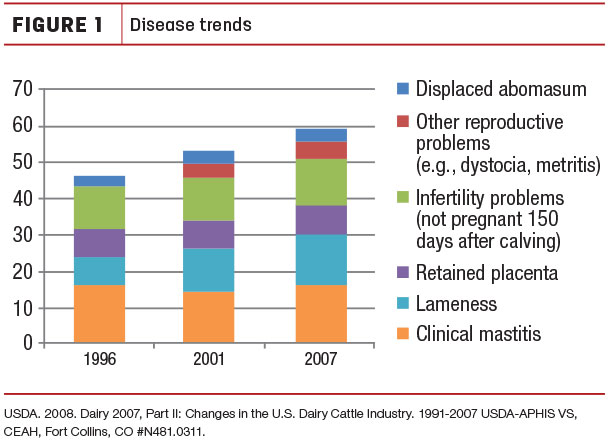Key takeaways for improving milk quality Let’s think about what makes for a profitable cow on your dairy. Yes, the cow is productive – strong milk production, the right balance of fluid and solids, and breeds back in a timely manner to tackle the next lactation – but, also, the cow is healthy.
Common diseases, such as mastitis, can cost between $155 and $224 per case and quickly eat into your profits by robbing good production, adding costs for treatment, and requiring extra time and labor to treat unhealthy animals.
To help reduce mastitis and improve milk quality on your dairy, sound management practices are essential. But couple this with managing disease incidence through genomic selection, and this represents an opportunity to make more permanent and additive changes in mastitis prevalence and milk quality on your dairy and, most important, have more profitable cows in generations to come.
There’s a correlation between production and other traits
For years, genetic evaluation and selection in dairy cattle has largely focused on production traits such as milk and protein production.
But research has shown a positive genetic correlation between mastitis susceptibility and milk production that shouldn’t be ignored: This research has indicated animals with the higher genetic potential for yield are often more susceptible to mastitis.
In a recent study conducted by Zoetis and AgStar Financial Services, it was determined as somatic cell count (SCC) increased, energy-corrected milk yield and 21-day pregnancy risk decreased while death losses and days open increased. Even more, data show for every 100,000-cell increase in SCC, milk yield decreases by 5.2 pounds energy-corrected milk per cow per day.
Takeaway: If mastitis risk is ignored in selection and greater weight is placed on milk production, resistance to mastitis is expected to decrease.
The inclusion of mastitis risk or somatic cell score (SCS) genomic traits in selection programs can help neutralize undesirable correlated responses. Figure 1 shows dairies continue to be as challenged as ever in managing the health and reproduction of their cows.
 Additionally, the use of genomics provides predictions of genetic merit with greater reliability than what could be sensibly achieved using traditional progeny-based evaluation systems, especially in young animals.
Additionally, the use of genomics provides predictions of genetic merit with greater reliability than what could be sensibly achieved using traditional progeny-based evaluation systems, especially in young animals.
This is particularly relevant for lowly heritable traits where genomic predictions can provide more information than could ever be achieved in the lifetime of a typical cow.
The ability to directly select for mastitis risk, along with having sound management practices, can help produce substantial changes in mastitis prevalence. Association studies between genomic predictions and observed clinical mastitis indicate that genomic data of young calves and heifers can be used to effectively predict future udder health performance.
An effective method for selecting for improved milk quality is to incorporate the udder health traits (SCS and mastitis risk) with other economically important traits (production, fertility) into a selection index, such as Net Merit, Dairy Wellness Profit, Total Performance Index or Jersey Performance Index, using genomically enhanced predicting transmitting abilities.
Takeaway: Improving mastitis prevalence through genetic selection is possible when coupled with sound management practices.
Using genetic evaluations for mastitis and udder health in breeding programs
The availability of industry SCS evaluation programs and the incorporation of them into multi-trait indexes have helped U.S. dairy breeders reverse the trend of increases in clinical mastitis cases and also reduce the national herd average test-day SCC from 319 in 2003 to 199 cells per milliliter in 2013. Multi-trait selection indexes help producers select for several traits at once, taking into account genetic relationships and economic values.
When selection indexes such as Dairy Wellness Profit and Lifetime Net Merit provide comprehensive and specific information on wellness and other performance traits, it provides clarity and opportunity to make more profitable animal rankings and decisions.
This means breeders can select mastitis resistance at the same time as traits for improving production, fertility, type and longevity. By including more characteristics affecting profitability, an overall wellness index describes more genetic variation in profitability than other indexes.
Takeaway: Multi-trait selection indexes are one of the best ways to help make economically sound selection decisions.
Improving health or wellness traits by including genetic selection as a part of the overall management practice is a good opportunity to help manage disease incidence and, ultimately, reduce the dramatic negative effect both clinical and non-clinical mastitis have on farm profitability.
Although mastitis and udder health are strongly influenced by the environment, the incorporation of SCS and mastitis traits into the genetic evaluation is clear evidence to support the influence of genetics on udder health.
It’s part of a comprehensive plan for improving dairy production and can be used to enhance the value of other strategies to help manage disease and milk quality. ![]()
References omitted but available upon request. Click here to email an editor.

-
Fernando Di Croce
- Director, Global Genetics - Technical Services
- Zoetis
- Email Fernando Di Croce





